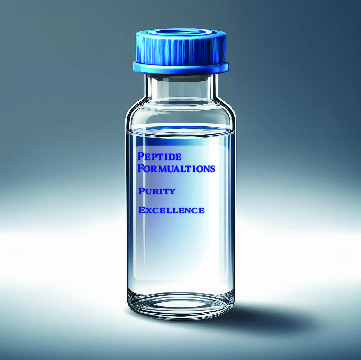Explore Our Product Range
Product Overview for Institutions and Researchers
Product Quantities:
Standard Quantities: We provide research peptides in quantities tailored to typical research needs, ranging from milligram to gram amounts. These quantities are ideal for initial experiments or smaller-scale studies.
Bulk Quantities: For larger-scale projects or ongoing research, we offer bulk peptides starting at 500 mg, with options to purchase up to 1 kg or more. Bulk orders are ideal for extensive research programs or institutional needs.
Product Form:
Lyophilized Powder: Our research peptides are provided in lyophilized (freeze-dried) powder form. This method preserves peptide stability and extends shelf life, ensuring the integrity and effectiveness of the peptides for your research needs. The lyophilization process also makes the peptides easier to store and handle.
Product Packaging:
Vial: Our research peptides are packaged in 5 ml clear A/S Type 1 glass serum vials. The clear borosilicate glass allows the vials to withstand a wide variety of contents, including acids, pharmaceuticals, alkalis, and essential oils, ensuring compatibility with a broad range of research applications.
Stoppers: Each vial is sealed with a rubber butyl stopper, which provides an effective barrier against contamination and maintains the integrity of the peptides.
Caps: The vials are topped with 22 mm aluminum caps with blue color coding for easy identification. This combination of materials ensures a secure seal and protects the contents during storage and transportation.
Product Handling:
Storage: Store the lyophilized peptide powders in a cool, dry place away from direct sunlight. Ideal storage temperatures are typically between 2°C and 8°C (36°F and 46°F). For longer-term storage, consider keeping them in a freezer to maintain stability.
Reconstitution: When ready to use, reconstitute the lyophilized powder with an appropriate solvent as specified in the provided instructions. Ensure that all equipment used for reconstitution is sterile to avoid contamination.
Handling: Handle vials with clean, dry hands or gloves to prevent contamination. Use aseptic techniques when opening and closing vials. Avoid direct contact with the powder to maintain its integrity.
Use of Sterile Equipment: When withdrawing the peptide solution from the vial, always use sterile syringes and needles. This prevents contamination of the peptide solution, which is crucial for maintaining the integrity and accuracy of your research results. Sterilized equipment minimizes the risk of introducing microorganisms or other contaminants that could alter the peptide’s properties or interfere with experimental outcomes.
Expiration: Adhere to the expiration dates provided on the certificates of analysis. Do not use peptides past their expiration date as their stability and efficacy cannot be guaranteed.
Disposal: Dispose of any unused or expired peptides and vials according to local regulations and institutional guidelines for hazardous materials. Ensure that all disposal practices are compliant with safety and environmental regulations.
Research peptides are short chains of amino acids that are used primarily in scientific research. Unlike pharmaceutical peptides used for medical treatments, research peptides are typically not approved for human use. Instead, they are utilized in labs to study their effects, mechanisms, and potential applications.
Here’s an overview of key points about research peptides:
1. Structure and Function
- Composition: Peptides are made up of 2-50 amino acids linked by peptide bonds. The sequence and composition of these amino acids can influence the peptide’s function.
- Function: Peptides can act as signaling molecules, hormones, or inhibitors, and they play roles in various biological processes.
2. Common Types and Uses
- Growth Hormone Releasing Peptides (GHRPs): Such as GHRP-6 and GHRP-2, used to study growth hormone release.
- Melanotan Peptides: Like Melanotan II, which are studied for their effects on skin pigmentation and appetite.
- Cyclic Peptides: Often researched for their potential stability and specific binding properties.
3. Research and Applications
- Biological Research: Peptides are used to understand physiological processes, such as hormone regulation, immune responses, and cell signaling.
- Pharmacological Research: They help in developing new drugs or therapies by investigating how peptides interact with various biological targets.
- Synthetic Biology: Peptides are used in the creation of synthetic pathways or in the modification of biological systems.
4. Safety and Regulations
- Not for Human Consumption: Research peptides are not approved for use in humans and should not be used outside of a research setting.
- Regulations: The legal status of research peptides varies by country. In many places, they are regulated as research chemicals rather than drugs.
5. Procurement and Use
- Sources: Typically purchased from specialized suppliers who deal in research chemicals.
- Handling: Proper handling and storage are crucial to maintaining the stability and integrity of the peptides.
6. Ethical Considerations
- Research Ethics: Researchers must adhere to ethical guidelines, ensuring that their work with peptides does not involve any harm to humans or animals unless it is part of a regulated study.
In summary, research peptides are valuable tools for understanding biological processes and developing new therapeutic approaches, but their use is restricted to research settings due to safety and regulatory concerns.

